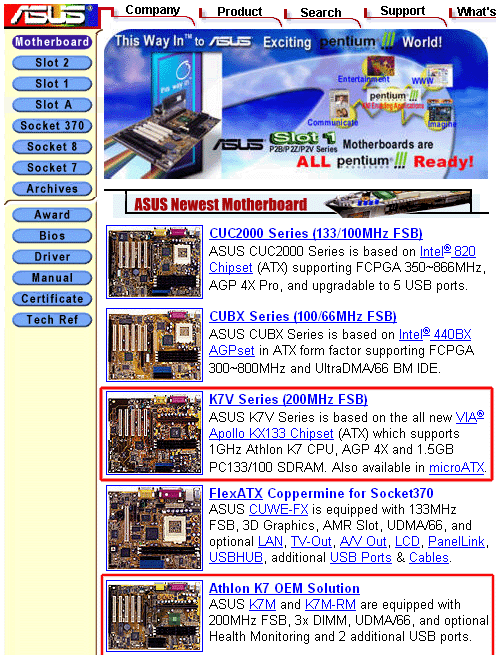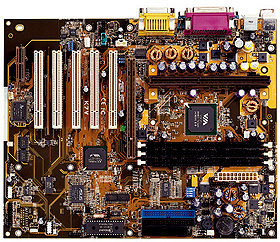Not too long ago we took a look at ASUS' first KX133 based Athlon solution, the K7V-RM. The K7V-RM left us with a very positive feeling towards ASUS' contribution to the Athlon motherboard market. The board was extremely stable, an argument verified by AMD as the K7V-RM was one of the first two motherboards to become certified for 1GHz operation and had just about every feature we could ask for on a KX133 board.
The unfortunate downside to the K7V-RM was that it was a microATX solution geared towards the OEM market, not towards the PC hardware enthusiast market that we tailor to. Luckily ASUS wasn't going to cripple their KX133 line by only releasing a microATX version of the board and a full ATX version of the K7V-RM, dubbed the K7V, was due out for release shortly after the K7V-RM.
We definitely had some very high hopes for the K7V because, if it was to be anything like the K7V-RM then it would surely turn out to be one of the best if not the best ATX KX133 motherboard for Athlon owners. One of the biggest fears that we had about the K7V wasn't related to it being able to live up to our expectations (ASUS would really have to screw up the design in order for the K7V to be that different from the K7V-RM), but rather, we were worried that ASUS would once again take the route of the K7M and blatantly deny the existence of the K7V as a member of their product line.
To our relief we, as well as a number of satisfied Athlon owners can now see the K7M line of Athlon motherboards as well as the new K7V and K7V-RM boards listed on ASUS' latest motherboards page as official ASUS products. The K7V and K7V-RM are also going to be sold in official ASUS boxes, not the white OEM boxes that the first K7Ms were sold in, which was a little more than just peculiar.

So does the K7V measure up to the expectations that we had for it after testing its microATX sibling? In one word, yes.
|
Motherboard Specifications |
|
| CPU Interface |
Slot-A
|
| Chipset |
VIA KX133
VIA 371 North Bridge VIA 686A South Bridge |
| L2 Cache |
N/A (on-chip)
|
| Form Factor |
ATX
|
| Bus Speeds |
90 / 92 / 95 / 97 / 100 / 101 / 103
/ 105 / 107
110 / 112 / 115 / 117 / 120 / 122 / 124 / 127 / 130 133 / 136 / 140 / 145 / 150 / 155 |
| Voltages Supported |
1.30v - 2.05v (in 0.05v increments)
|
| Memory Slots |
3 168-pin DIMM Slots
|
| Expansion Slots |
1 AMR Slot
1 AGP Pro Slot 5 PCI Slots (5 Full Length) 0 ISA Slots |
| AC'97 |
Cirrus Logic CS4299 CrystalClear
SoundFusion
|
| BIOS |
AWARD Medallion BIOS v6.00
|
The Good
Just as the K7V-RM was the successor to the K7M-RM, the K7V, it's ATX brother, is the successor to the extremely popular K7M, which was based on the old AMD 750 chipset. As we mentioned at the start of the review, the microATX K7V-RM wasn't exactly ideal for the PC hardware enthusiast market that comprises the majority of our readers, but it was perfect for not only OEMs looking to build more flexible systems but also end users that are happy with only 3 PCI slots.
Like the AOpen AK72, the K7V is built upon an oversized PCB that closely resembles an extended ATX form factor motherboard. The K7V can be added to the list including the FIC SD-11 and the aforementioned AK72 that are built on these larger PCBs, and although it may be easier to work with a motherboard that features a larger PCB, it isn't a positive feature from an installation standpoint as the larger boards can get quite cramped in your average mid-tower ATX case. If you happen to have a larger tower then you shouldn't have anything to worry about, but be warned that the K7V is about an inch (2.54cm) deeper than the K7M and most other ATX Athlon boards.
What makes the K7V series of boards different from the older K7M series is that these boards use VIA's KX133 chipset, which has just recently started appearing in motherboards on the market. Located between the Slot-A connector and the memory banks is the KX133's North Bridge. The 371 North Bridge brings the main features of the KX133 to the table: 133MHz memory bus and AGP 4X support. The beauty of the 371's memory controller is that it can run your memory at either 133MHz or 100MHz using a multiplier of the FSB frequency. So those users with PC133 SDRAM can take advantage of the increased bandwidth (1.06GB/s vs. 800MB/s) over PC100 SDRAM, while allowing backwards compatibility with older PC100 SDRAM. While the memory controller boasts support for Virtual Channel SDRAM, we have yet to see a real reason for upgrading to VC100/VC133 SDRAM since the performance improvement over regular PC100/PC133 SDRAM is negligible in real world situations, which doesn't justify the price premium that you currently have to pay for it.
The K7V, as is the case with most Athlon motherboards, features 3 DIMM slots capable of accepting PC100/PC133 or VC100/VC133 SDRAM running at either a 3:3 (1:1) ratio with the FSB (by default, 100MHz) or a 4:3 ratio with the FSB (133MHz by default). Although the K7V does feature a large PCB, the memory slots were luckily placed away from the edge of the board, which limits their interference with hard drive bays in more cramped cases.











0 Comments
View All Comments